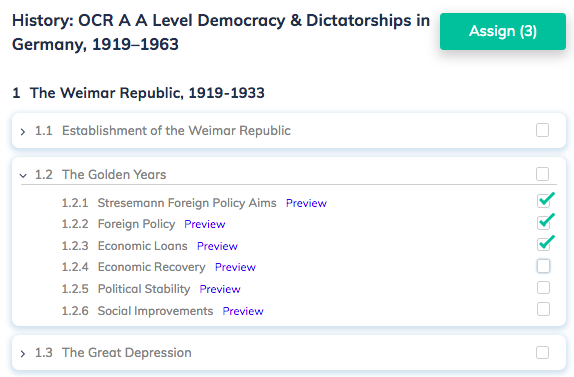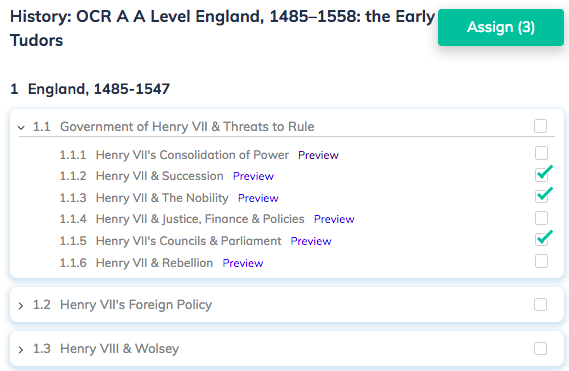

A Level OCR History Primer for Teachers
Setting and marking every single History homework can take an awfully long time. Time that could have been spent on lesson planning, watching Manchester United lose, or with family.
However, this should no longer be the case. We wanted to try to support the formation of students' knowledge using the best History content and the best algorithms. Via this OCR History primer I aim to detail all the coursework sections that have been incorporated in the free Seneca revision courses.
Via the teacher platform you're now able to invite your students and set assignments in under 30 seconds. All of their History homework will be automatically marked, and their weaknesses automatically highlighted. But that's not all. You're now also getting insights into what topics the class understands well and what topics need attention during one of the upcoming classroom sessions. That way you can really bring your class to the next level, and even set individual homework based on each student's own progress.

Vital Resources for You:
Setting History A Level Homework on Seneca
The benefits for A Level History teachers are:
- It's free to use.
- Insights into students' performance are granular and free.
- All revision courses are written by examiners and subject experts to ensure the content matches the exam board specifications.
- It's highly engaging making students study more often and for longer periods of time.
Curriculum: History: OCR A A Level Democracy & Dictatorships in Germany, 1919–1963
1 The Weimar Republic, 1919-1933
1.1 Establishment of the Weimar Republic
1.1.1 Impact of WW1
1.1.2 Peace Settlement
1.1.3 The Weimar Constituion
1.1.4 Problems of Weimar Constitution
1.1.5 Political Turmoil
1.1.6 Economic Issues
1.2 The Golden Years
1.2.1 Stresemann Foreign Policy Aims
1.2.2 Foreign Policy
1.2.3 Economic Loans
1.2.4 Economic Recovery
1.2.5 Political Stability
1.2.6 Social Improvements
1.3 The Great Depression
1.3.1 Impact of the Great Depression
1.3.2 Elections & Governments 1929-1933
1.3.3 Rise & Appeal of Nazism
1.3.4 'Backstairs Intrigue'
1.3.5 Hitler Becomes Chancellor
2 Establishment of the Nazi State, 1933-1939
2.1 Consolidation of Power
2.1.1 Hitler's Consolidation of Power
2.1.2 Gleischaltung
2.1.3 Government & Propaganda
2.1.4 Machinery of Terror
2.1.5 Opposition
2.1.6 Social Policies
2.1.7 Economic Policies
2.1.8 Racial Policies
2.1.9 Benefits of Nazi Rule
3 The Impact of War & Defeat, 1939-1949
3.1WW2
3.1.1 War Economy
3.1.2 Total War
3.1.3 Racial Policies
3.1.4 Opposition
3.2 Consequences of WW2
3.2.1 Impact of WW2
3.2.2 Development of the Cold War
3.2.3 Division of Germany
3.2.4 Development of the Cold War
3.2.5 Berlin Blockade
4 Divided Germany, 1949-1963
4.1 Creation of West Germany
4.1.1 Formation of West Germany
4.1.2 Economic Recovery
4.1.3 Political Stability
4.1.4 Social Stability
4.1.5 Foreign Policy
4.1.6 Berlin Wall
4.1.7 Adenauer's Decline
4.1.8 West Germany by 1963
4.2 Creation of the GDR
4.2.1 GDR in 19494.2.21953
4.2.3 Economy
4.2.4 Social Change
4.2.5 Control Over Society
4.2.6 East Germany by 1963

Curriculum: History: OCR A A Level England, 1485–1558: the Early Tudors
1 England, 1485-1547
1.1 Government of Henry VII & Threats to Rule
1.1.1 Henry VII's Consolidation of Power
1.1.2 Henry VII & Succession
1.1.3 Henry VII & The Nobility
1.1.4 Henry VII & Justice, Finance & Policies
1.1.5 Henry VII's Councils & Parliament
1.1.6 Henry VII & Rebellion
1.2 Henry VII's Foreign Policy
1.2.1 Henry VII's Relationship with Foreign Powers
1.3 Henry VIII & Wolsey
1.3.1 Henry VIII's Consolidation of Power
1.3.2 Henry VIII & His Government
1.3.3 Henry VIII's Relationship with Foreign Powers
1.3.4 Wolsey
1.3.5 Wolsey & the Church
1.3.6 Break from Rome
1.4 The Reign of Henry VIII After 1529
1.4.1 The Henrician Reformation
1.4.2 Religious Change & Opposition
1.4.3 Impact of Religious Upheaval
1.4.4 Cromwell
1.4.5 Factions at Court
1.4.6 Foreign Policy in the 1540s
2 Mid Tudor Crises, 1547-1558
2.1 Stability of the Monarchy
2.1.1 Constraints on Edward VI & Mary I
2.1.2 Mary I & Her Rule
2.1.3 Edward VI & the Succession Issue
2.1.4 Factions Under Edward VI
2.1.5 Factions under Mary I
2.2 Religious Changes
2.2.1 Protestantism Under Edward VI
2.2.2 Catholicism Under Mary I
2.3 Religion & Unrest
2.3.1 Edward VI & Rebellions
2.3.2 Mary VI & Rebellions
2.3.3 Social & Economic Developments

Curriculum: History: OCR A A Level England 1547-1603: the Later Tudors
1 Mid Tudor Crises, 1547-1558
1.1 Stability of the Monarch
1.1.1 Constraints on Edward VI & Mary I
1.1.2 Mary I & Her Rule
1.1.3 Edward VI & the Succession Issue
1.1.4 Factions Under Edward VI
1.1.5 Factions Under Mary I
1.2 Religious Changes
1.2.1 Protestantism Under Edward VI
1.2.2 Catholicism Under Mary I
1.3 Religion & Unrest
1.3.1 Edward VI & Rebellion
1.3.2 Mary I & Rebellion
1.3.3 Social & Economic Developments
2 Elizabethan England, 1558-1603
2.1 Elizabeth & Religion
2.1.1 Domestic Situation in 1558
2.1.2 Foreign Situation in 1558
2.1.3 Elizabethan Settlement
2.1.4 Puritan Threat
2.1.5 Catholic Threat
2.2 Elizabethan Government
2.2.1 Elizabeth & Court
2.2.2 Elizabeth's Royal Authority
2.2.3 Elizabeth & Government
2.2.4 Attitudes to Elizabeth & Marriage
2.2.5 Mary Queen of Scots
2.3 Finances, the Economy & Society
2.3.1 Finances
2.3.2 Trade
2.3.3 Poverty
2.4 Elizabethan Later Years, 1588-1603
2.4.1 Elizabeth & Parliament
2.4.2 Relations With Spain
2.4.3 Spanish Armada
2.4.4 Social Distress
2.4.5 Irish Rebellion
2.4.6 Essex's Rebellion
2.4.7 Elizabeth I's Reputation







